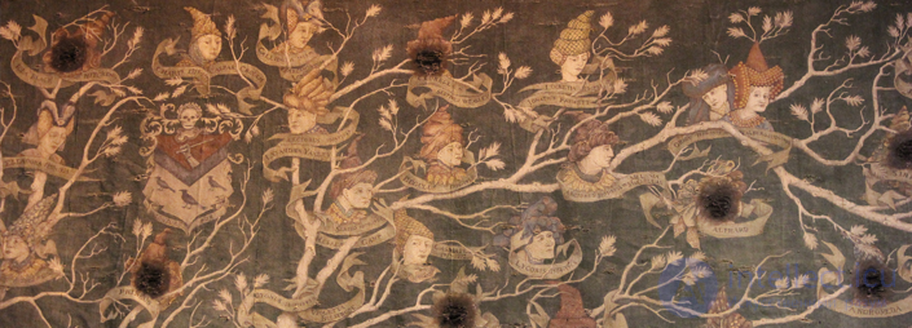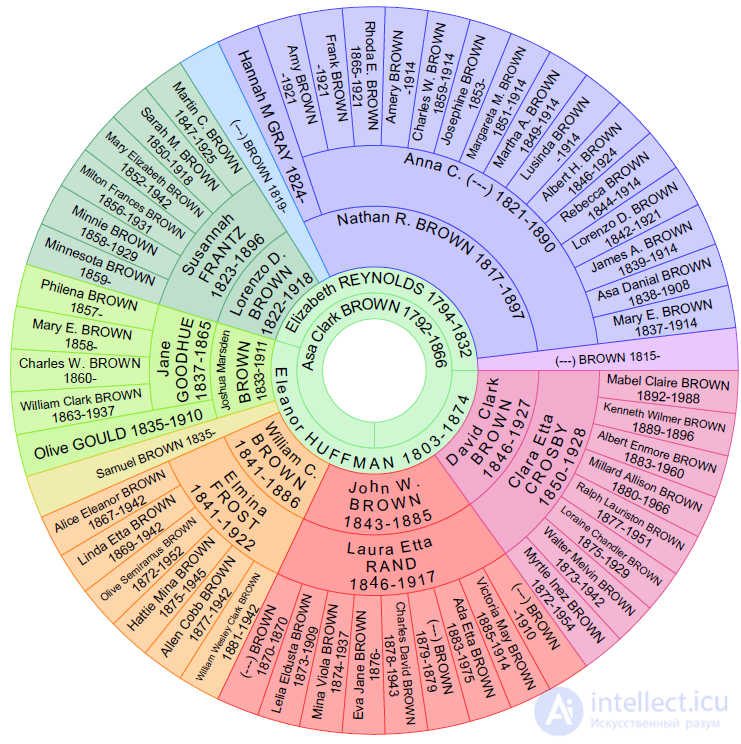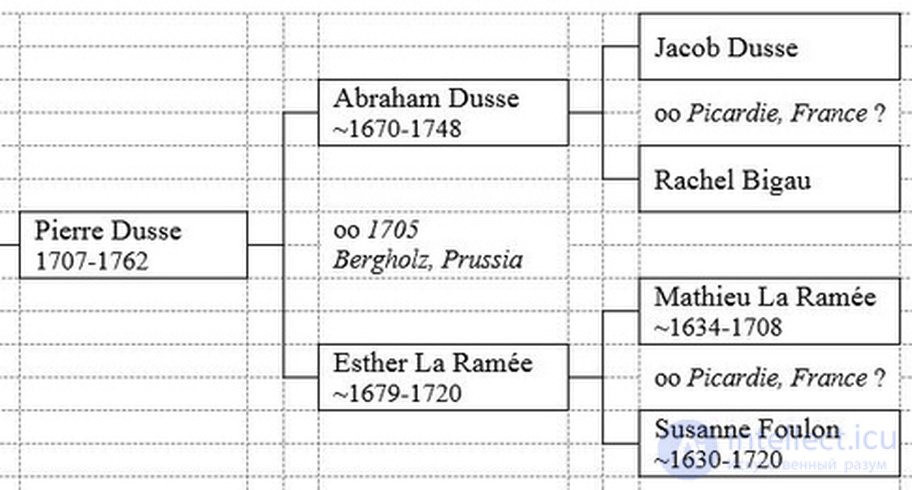Lecture
Это окончание невероятной информации про родословные дерево.
...
and aristocracy, genealogical societies, historical archives, funds, research organizations - all these institutions are engaged in the restoration of the traditional, carefully documented construction of genealogies.
As a rule, a person is satisfied with even an approximate picture, confirmed by the testimony of close or distant relatives. In these cases, genealogical trees are an instrument of self-identification, a means of self-affirmation and self-preservation of the individual in history, the memory of descendants. It is important that these trees are not made by titled persons concerned with claims to inheritance and privileges, but by ordinary citizens. Therefore, mass genealogy is subject not to the laws of law, but to the laws of general psychology. In particular, it “forces out” characters that are unpleasant for respondents; it is highly selective. Some characters may not be included in it according to the “laws of common sense” or the laws of “normal perception”.
In our practice, there was a case when one author stubbornly did not include in his family tree an older sister who died in infancy. He knew about her existence very well, but the psychological conviction that he does not have and never had living sisters (either younger or older), and the one that he had died at the age of nine months, a year and a half before his own birth, turned out to be stronger than rational factual knowledge. When this psychological barrier was overcome, another question arose: should the “unfulfilled brother” – a stillborn boy – be included in the genealogy (the author also knew about this fact from his mother’s life very well). If the study had been devoted to the problems of childbirth, then all three cases of birth (stillborn infant; daughter who died at the age of nine months and, finally, the son who survived to the present day – the author of the family tree) would have had the status of relevant information. In order to study the mechanisms of reproductive behavior, it is important for demographic science to record not only births, but also conceptions and terminations of pregnancy (natural and artificial). But since this genealogy served the typical purposes of “mass genealogy” – knowledge of one’s own roots, self-identification, etc. – the first two births represent only evidence of the mother’s persistent desire to have a child.
The reasons for inaccuracies or omissions in genealogical trees, as well as their discrepancies with actual “historical” family events, can be different. Our examples show that such situations are quite typical for genealogies that we call mass. In this regard, it is reasonable to raise the question of the degree of reliability of the information contained in such sources. Our fundamental position is that in a survey situation, people rarely tell lies. This principle is even more applicable to mass genealogy. At the same time, when referring to family trees, it should be taken into account that their compilers may forget something, may not know about some moments of their own history, and sometimes may not even guess that information about their family can be obtained somewhere. Nevertheless, mass genealogy, in our opinion, is a source of reliable and trustworthy information about the life history of families. In the process of collecting empirical data, it is necessary to carefully work out methodological and methodological issues, think about techniques that would help compilers of genealogies (non-professionals) activate their memory, escape the influence of prejudices and stereotypes, suggest ways (channels, sources) to search for the necessary additional information. Naturally, all this contributes to increasing the reliability and validity of the data.
In our opinion, genealogical trees are a full-fledged source of information for studying a wide range of sociological problems. The very idea of mass genealogy can have a significant social effect, especially in the context of deep social transformations that Russian society is experiencing. In addition, genealogy performs some social and socio-psychological functions. Experience working with schoolchildren and students has shown that many of those who began to build their genealogies were so involved in this work that they continued to search for the information they believed to be missing completely independently. And then, again independently, they began to work on the texts of family chronicles or biographies of their parents, grandparents, not to mention their own biographies. The genealogical impulse stimulates the awakening of the biographical impulse. However, the opposite effect is not uncommon. In some biographical interviews, great difficulties arose at the beginning of the work - the narrator could not begin to tell about his life. The interviewer's recommendation to try to draw a family tree first turned out to be the most effective means of overcoming initial difficulties in most cases. Among the materials of the biographical fund, both those that came to us "of their own accord" and those that were, in a certain sense, stimulated by us, family trees are also not uncommon. At the same time, according to the testimony of the authors themselves, the construction of a family tree helped them to more fully recall specific life situations, life circumstances associated with different people, and generally caused a flow of vivid memories and associations. In addition, the construction of a genealogy helped them to organize, structure, and compositionally construct the text of the autobiography. Thus, another very important, in our opinion, social function of genealogy emerges - the function of stimulation, activation of the biographical impulse and biographical (historical) memory.
The revival of historical memory, the genuine interest of people not only in history in general, but also in their own social roots, is one of the distinctive features of modern Russia (possibly the entire post-Soviet space and the countries of the so-called socialist camp). Various motives support this interest, people try to realize it in different ways, but, as a rule, it has a selfless motivation. Genealogical trees seem to be one of the most adequate ways not only to satisfy this interest, but also to study the process of the revival of historical memory itself.
This process is partly manifested in the “mass genealogy”, which first appeared spontaneously, and then supported by some researchers (which include themselves). Today, thanks to the disinterested interest of people to their roots, the inner need for self-determination (identification), the genealogical trees acquire cultural status. Perhaps, as economic reforms progressed, they would regain their legal status in Soviet times.
The appeal of sociologists to sources of this type, in our opinion, is very promising, but it requires solving serious methodological and substantive problems. The experience of mastering modern computing technology shows that computer technologies are effective only when the researcher is able to fully and meaningfully describe his subject area at the model level.
We tried to describe and analyze the structure of genealogies in order to understand how they can be used in sociological research. At the same time, we had in mind approaches to the justification and development of a database specifically designed for this type of information. It is for this reason that we are concerned with the invariance, if you like, the universality of the characteristics of genealogical trees. We interpret invariance primarily as thematic “non-commitment”. The task is to develop general principles for such a database and general algorithms for managing it. If this task is solved satisfactorily, then the inclusion of specific thematically committed characteristics and features will become, as they say, a matter of technique.
Appendix Information about the characters of the genealogical tree of M.O. Zheltoukhova (St. Petersburg State Attestation Commission, 1992/93 academic year)
|
N |
Surname Name Patronymic | Dates of life | Education | Occupation | Location |
|
1 |
Borisovskaya Matryona Makarovna | 1887-1943 | Velikolukskaya region, Leningrad | ||
|
2 |
Borisov Andrey Stepanovich | 1883-1942 | peasant | Velikolukskaya region, Leningrad | |
|
3 |
Borisovskaya Ekaterina Andreevna | 1919 | working | Leningrad | |
|
4 |
Borisov Ivan Andreevich | 1910-1944 | der. Tyukhtilovo, Velikolukskaya region | ||
|
5 |
Borisov Semen Andreevich | 1913-1942 | der. Tyukhtilovo, Velikolukskaya region | ||
|
6 |
Borisovsky Alexander Andreevich | ? - 1981 | Leningrad | ||
|
7 |
Borisov Serafim Andreevich | 1929 | disabled | Sestroretsk | |
|
8 |
Borisovskaya Lyubov Andreevna | 1924 | specialized secondary | cook | Leningrad |
|
9 |
Borisovskaya Antonina Andreevna | 1922 | specialized secondary | seller | |
|
10 |
Popilyshkin Mikhail Martynovich | 1904 | turner | Leningrad | |
|
11 |
Dubinetskaya Elena Viktorovna | 1886-1940 | a housewife | Kuvshinovo Kalinin region | |
|
12 |
Dubinetsky Vasily Stanislavovich | 1880-1931 | geography teacher | Kuvshinovo Kalinin region | |
|
13 |
Dubinetskaya Valentina Vasilyevna | 1928 | kindergarten teacher | Vyborg | |
|
14 |
Zheltoukhov Konstantin Vasilyevich | 1921-1983 | military school | military | Germany, Kalinin |
|
15 |
Dubinetsky Stanislav Vasilyevich | 1925-1988 | higher | geologist | Vyborg |
|
16 |
|||||
|
17 |
Dubinetsky Yury Stanislavovich | 1947 | higher, LISI | Vyborg | |
|
18 |
Dubinetskaya Galina Stanislavovna | 1951 | pharmacist | Vyborg | |
|
19 |
Zheltoukhov Oleg Konstantinovich | 1947 | higher | military representative | Leningrad |
|
20 |
Zheltoukhova Liliya Mikhailovna | 1947 | higher | engineer NPO Uran | Leningrad |
|
21 |
|||||
|
22 |
Zheltoukhova Yana Olegovna | 1980 | schoolgirl | Leningrad | |
|
23 |
Kospareva Raisa Mikhailovna | 1939 | higher education | economist | Leningrad |
|
24 |
Kosparev Lymond Konstantinovich | 1935 | higher | military | Leningrad |
|
25 |
Gorshkova Liliya Laymondovna | 1960 | higher education | Leningrad | |
|
26 |
Gorshkov Igor Nikolaevich | 1960 | higher, LIAP | Leningrad | |
|
27 |
|||||
|
28 |
|||||
|
29 |
Kapustin Yuri Semenovich | 1947 | |||
|
thirty |
|||||
|
31 |
|||||
|
32 |
|||||
|
33 |
Kapustina Elena Yuryevna | 1974 | |||
|
34 |
|||||
|
35 |
|||||
|
36 |
Zheltoukhova Marina Olegovna | 1973-1993 | n / higher | student LIIC them. Krupskaya | SPb |

Before you start creating a family tree, it is necessary to determine the type of genealogical research. In this science there are two main types:

The family tree of Maria Justina and Johann Maximilian was completed in 1634. (Ascending, mixed type) |

The family tree of the Venetian traveler Carl Maggi (Carlo Maggi) was made by the artist Paolo Veronese in the years 1568-73. (Male descending tree type) |
The most common graphic represented pedigree is a tree . He is painted differently: sometimes, the descendant is at the root of the tree, and its ancestors form a crown ( for example, the family tree of Maria Justina and Johann Maximilian ), or vice versa, at the root of the tree is an ancestor, in the crown are descendants ( for example, the Genealogical tree Venetian traveler Carl Maggie ). More common is the first display method.
An ascending male-type study traces the line of the father. Each generation will have one foreplay. This method is useful when investigating the origin of a surname. The figure below shows the father-son chain from Adam to Jesus Christ.

Genealogical tree of Jesus Christ ("Tree of Jesse".) Done around 1480. Illustration to the death book of Yakub Voragine (Jacobus de Varagine) "Golden Legend" (Legenda Aurea)
An ascending mixed tree is considered to be a classic, water shows all direct ancestors in the male and female lines. The number of ancestors doubles in each knee relative to the previous one. An example of such a tree can be seen above (The genealogical tree of Maria Justina and Johann Maximilian).
The male siphne tree reflects all descendants born to male representatives of the genus. The descendants born by women are considered representatives of other clans (the clans of their husbands), therefore they are not indicated. An example of such a tree can be seen above (Family tree of the Venetian traveler Carl Maggi).
A low-speed tree of mixed type reflects all descendants of a particular person, regardless of the article. In this tree there are different surnames of different genera.

Family tree of the Simpsons from the TV series The Simpsons
It is advisable to combine the above methods: when you learn about a new ancestor, try to immediately find all its descendants.
Other methods of graphic display include circular , horizontal and vertical tables.
In countries such as the United Kingdom and France, most often used circular tables and . In the center of the table is the person for whom the pedigree is compiled, in one half the ancestors are from the father, in the other - by the mother (for example, the pedigree of Konev Akim). It is believed that such tables can only be ascending. But to your attention a descending pie chart, for example, the genus Brown.

Pedigree Konev Akim (Rising, mixed type) |

Pedigree of the genus Brown (Descending mixed type) |
The easiest way to analyze the number and fullness of generations in the genealogical table, in which all generations are on the same vertical or horizontal. Most often such tables are ascending.

Vertical genealogy table
Now that you know the whole methodology of the graphical display of the pedigree, you can begin to visualize the data about your gender. Of course, the manual method is typical, but since the street is already in the 21st century, we will consider methods using a computer.
To build a family tree, you can use graphical programs, such as:
To simplify the work, you can download ready-made layouts and simply enter the names of ancestors / descendants. The downside is that if you want to create a full schedule with your relatives' siblings, you will not find a ready-made template on the Internet.
Also, you can download special genealogical programs to build a tree, or use the online resources. Here is a description of some of these resources.
Free program with the ability to purchase premium premium accounts that enhance the capabilities of users. The program was developed by the Israeli company MyHeritage. Mandatory registration on the site (the program will not start without registration). The main features of the program are:
Tree of Life program is easy to use, user-friendly interface is understandable even for beginners. The main features of the program:
A computer program for creating and managing genealogical databases. The main features of the program:
Genealogical program for the compilation of the genealogical tree and genealogical murals.
The main features of the program:
FamilySpace will help you quickly create a family tree for your family.
The main features of the program:
Часть 1 Genealogical (genealogical) trees as an object of sociological analysis
Часть 2 “Human” features of the method - Genealogical (genealogical) trees as
Comments
To leave a comment
Sociology
Terms: Sociology